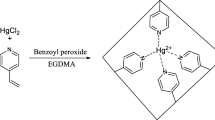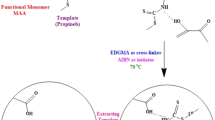Abstract
The efficiency and the reuse of a bisphenol-A molecularly imprinted polymer (BPA-MIP) were evaluated for the selective removal of several phenolic compounds and phenoxyacid herbicides from environmental water samples. The proper sorption and selective recognition ability of the MIP were studied in aqueous solution by the batch equilibrium technique. Furthermore, removal of the analytes studied by the MIP was carried out from river, tap and ground waters, and different factors, such as the sample volume, the solution pH or the analyte concentration in the sample, were studied. Results obtained indicated a rapid sorption of analytes by the MIP, being the sorption dependent on the concentration of analyte in the solution. The MIP showed an excellent affinity toward phenolic compounds and phenoxyacid herbicides, and removal efficiencies of over 70 % were achieved in aqueous solution. Removal efficiency was not affected by the pH or by the water type, although it was affected by the volume of water especially for nitrophenols when amounts in solution were ≥1 mg. Removal efficiencies recorded by the MIP for the highest volume of water assayed were around 20 % higher than those obtained with traditional sorbents for chlorophenols and bisphenols, and similar removal efficiencies were obtained for phenoxyacid herbicides. The use of the MIP provided a selective, simple, reliable and viable solution for removing these compounds from water, and it could be re-used at least 20 times without losing any removal efficiency.






Similar content being viewed by others
References
Bus JS, Hammond LE (2007) Regulatory progress, toxicology, and public concerns with 2,4-D: where do we stand after two decades? Crop Prot 26:266–269
Cacho C, Turiel E, Pérez-Conde C (2009) Molecularly imprinted polymers: an analytical tool for the determination of benzimidazole compounds in water samples. Talanta 78:1029–1035
Carabias-Martínez R, Rodríguez-Gonzalo E, Herrero-Hernández E (2005) Determination of triazines and dealkylated and hydroxylated metabolites in river water using a propazine-imprinted polymer. J Chromatogr A 1085:199–206
Carabias-Martínez R, Rodríguez-Gonzalo E, Herrero-Hernández E (2006) Behaviour of triazine herbicides and their hydroxylated and dealkylated metabolites on a propazine-imprinted polymer. Comparative study in organic and aqueous media. Anal Chim Acta 559:186–194
CEC-Council of the European Communities (1998) Council Directive 98/83/EC on the quality of water intended for human consumption. Off J Eur Commun L330:32–54
Dai CM, Geissen SU, Zhang YL, Zhang YJ, Zhou XF (2011) Selective removal of diclofenac from contaminated water using molecularly imprinted polymer microspheres. Environ Pollut 159:1660–1666
Dai CM, Zhang J, Zhang YL, Zhou XF, Duan YP, Liu SG (2012) Selective removal of acidic pharmaceuticals from contaminated lake water using multi-templates molecularly imprinted polymer. Chem Eng J 211–212:302–309
Feng QZ, Zhao LX, Yan W, Lin JM, Zheng ZX (2009) Molecularly imprinted solid-phase extraction combined with high performance liquid chromatography for analysis of phenolic compounds from environmental water samples. J Hazard Mater 167:282–288
Fernández-Álvarez P, Le Noir M, Guieysse B (2009) Removal and destruction of endocrine disrupting contaminants by adsorption with molecularly imprinted polymers followed by simultaneous extraction and phototreatment. J Hazard Mater 163:1107–1112
Fromme H, Küchler T, Otto T, Pilz K, Müller J, Wenzel A (2002) Occurrence of phthalates and bisphenol A and F in the environment. Water Res 36:1429–1438
Giles CH, MacEwan TH, Nakhwa SN, Smith D (1960) Studies in adsorption. Part XI. A system of classification of solution adsorption isotherms, and its use in diagnosis of adsorption mechanisms and in measurement of specific surface areas of solids. J Chem Soc 111:3973–3993
Han DM, Jia WP, Liang HD (2010) Selective removal of 2,4-dichlorophenoxyacetic acid from water by molecularly-imprinted amino-functionalized silica gel sorbent. J Environ Sci 22:237–241
Herrero-Hernández E, Carabias-Martínez R, Rodríguez-Gonzalo E (2009) Use of a bisphenol-A imprinted polymer as a selective sorbent for the determination of phenols and phenoxyacids in honey by liquid chromatography with diode array and tandem mass spectrometric detection. Anal Chim Acta 650:195–201
Herrero-Hernández E, Carabias-Martínez R, Rodríguez-Gonzalo E (2011) Behavior of phenols and phenoxyacids on a bisphenol-A imprinted polymer. Application for selective solid-phase extraction from water and urine samples. Int J Mol Sci 12:3322–3339
Herrero-Hernández E, Rodríguez-Gonzalo E, Andrades MS, Sánchez-González S, Carabias-Martínez R (2013) Occurrence of phenols and phenoxyacid herbicides in environmental waters using an imprinted polymer as a selective sorbent. Sci Total Environ 454–455:299–306
Koς I, Baydemir G, Bayram E, Yavuz H, Denizli A (2011) Selective removal of 17β-estradiol with molecularly imprinted particle-embedded cryogel systems. J Hazard Mater 192:1819–1826
Krupadam RJ, Khan MS, Wate SR (2010) Removal of probable human carcinogenic polycyclic aromatic hydrocarbons from contaminated water using molecularly imprinted polymer. Water Res 44:681–688
Le Noir M, Lepeuple AS, Guieysse AC, Mattiasson B (2007) Selective removal of 17b-estradiol at trace concentration using a molecularly imprinted polymer. Water Res 41:2825–2831
Li Y, Li X, Dong C, Li Y, Jin P, Qi J (2009a) Selective recognition and removal of chlorophenols from aqueous solution using molecularly imprinted polymer prepared by reversible addition-fragmentation chain transfer polymerization. Biosens Bioelectron 25:306–312
Li Y, Li X, Li YQ, Qi JY, Bian J, Yuan YX (2009b) Selective removal of 2,4-dichlorophenol from contaminated water using non-covalent imprinted microspheres. Environ Pollut 157:1879–1885
Lin Y, Shi Y, Jiang M, Jin Y, Peng Y, Lu B, Dai K (2008) Removal of phenolic estrogen pollutants from different sources of water using molecularly imprinted polymeric microspheres. Environ Pollut 153:483–491
Liu W, Liu X, Yang Y, Zhang Y, Xu B (2014) Selective removal of benzothiophene and dibenzothiophene from gasoline using double-template molecularly imprinted polymers on the surface of carbon microspheres. Fuel 117:184–190
Luo XB, Zhan YC, Huang YN, Yang LX, Tu XM, Luo SL (2011) Removal of water-soluble acid dyes from water environment using a novel magnetic molecularly imprinted polymer. J Hazard Mater 187:274–282
Lütfi Yola M, Eren T, Atar N, Wang S (2014a) Adsorptive and photocatalytic removal of reactive dyes by silver nanoparticle-colemanite ore waste. Chem Eng J 242:333–340
Lütfi Yola M, Eren T, Atar N (2014b) A novel efficient photocatalyst based on TiO2 nanoparticles involved boron enrichment waste for photocatalytic degradation of atrazine. Chem Eng J 250:288–294
Mohanty K, Das D, Biswas MN (2006) Preparation and characterization of activated carbons from Sterculia alata nutshell by chemical activation with zinc chloride to remove phenol from wastewater. Adsorption 12:119–132
Mompelat S, Le Bot B, Thomas O (2009) Occurrence and fate of pharmaceutical products and by-products, from resource to drinking water. Environ Int 35:803–814
Pan J, Li L, Hang H, Ou H, Zhang L, Yan Y, Shi W (2013) Study on the nonylphenol removal from aqueous solution using magnetic molecularly imprinted polymers based on fly-ash-cenospheres. Chem Eng J 223:824–832
Sahiner N, Ozay O, Aktas N (2011) Aromatic organic contaminant removal from an aqueous environment by p(4-VP)-based materials. Chemosphere 85:832–838
Sanchez-Martin MJ, Rodriguez-Cruz MS, Andrades MS, Sanchez-Camazano M (2006) Efficiency of different clay minerals modified with a cationic surfactant in the adsorption of pesticides: influence of clay type and pesticide hydrophobicity. Appl Clay Sci 31:216–228
Tan F, Sun D, Gao J, Zhao Q, Wang X, Teng F, Quan X, Chen J (2013) Preparation of molecularly imprinted polymer nanoparticles for selective removal of fluoroquinolone antibiotics in aqueous solution. J Hazard Mater 244–245:750–757
Thuy PT, Anh NV, van der Bruggen B (2012) Evaluation of two low-cost–high-performance adsorbent materials in the waste-to-product approach for the removal of pesticides from drinking water. Clean Soil Air Water 40:246–253
Wang S, Peng Y (2010) Natural zeolites as effective adsorbents in water and wastewater treatment. Chem Eng J 156:11–24
Yu Q, Deng S, Yu G (2008) Selective removal of perfluorooctane sulfonate from aqueous solution using chitosan-based molecularly imprinted polymer adsorbents. Water Res 42:3089–3097
Zhang ZB, Hu JY (2008) Selective removal of estrogenic compounds by molecular imprinted polymer (MIP). Water Res 42:4101–4108
Zolgharnein J, Shahmoradi A, Ghasemi J (2011) Pesticides removal using conventional and low-cost adsorbents: a review. Clean Soil Air Water 39:1105–1119
Acknowledgments
The Spanish Ministry of Science and Innovation (Projects CTQ 2011-24075 and AGL2010-15976/AGR) is gratefully acknowledged for its financial support for this work. Corresponding author thanks the CSIC for his JAE-Doc contract, co-financed by European Structural and Social Funds (ERDF-ESF).
Author information
Authors and Affiliations
Corresponding author
Rights and permissions
About this article
Cite this article
Herrero-Hernández, E., Rodríguez-Gonzalo, E., Rodríguez-Cruz, M.S. et al. Efficiency of a molecularly imprinted polymer for selective removal of phenols and phenoxyacids from contaminated waters. Int. J. Environ. Sci. Technol. 12, 3079–3088 (2015). https://doi.org/10.1007/s13762-014-0721-x
Received:
Revised:
Accepted:
Published:
Issue Date:
DOI: https://doi.org/10.1007/s13762-014-0721-x




